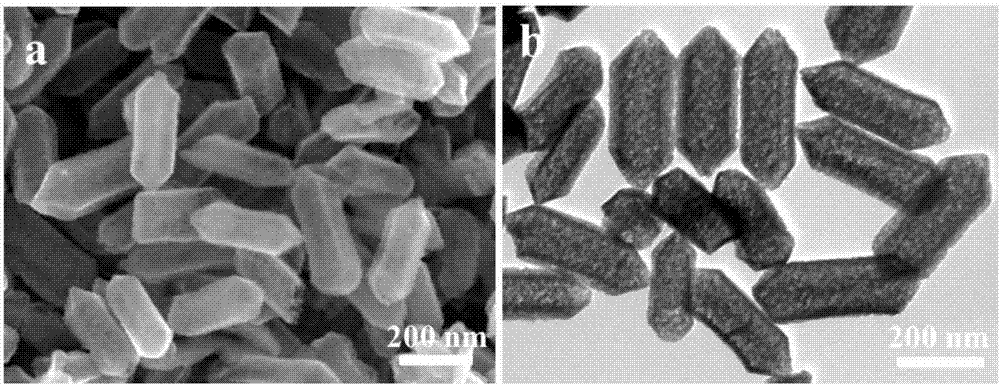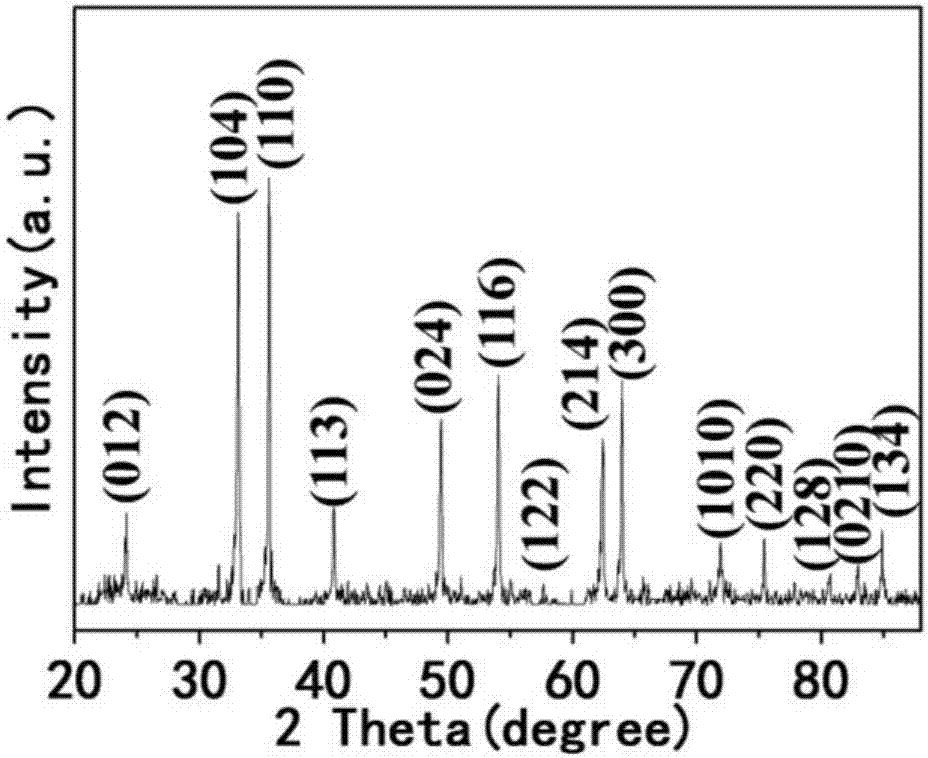Preparation and application method for hollow porous nano alpha-Fe2O3 hexagonal prism material
A hexagonal prism and hollow porous technology is applied in the fields of energy materials and electrochemistry, which can solve the problems such as unreported hexagonal prism materials, and achieve the effects of good comprehensive electrochemical performance, reduction of electrode pulverization effect, and stable rate performance.
- Summary
- Abstract
- Description
- Claims
- Application Information
AI Technical Summary
Problems solved by technology
Method used
Image
Examples
Embodiment 1
[0031]Stir 0.2 g of fumaric acid, 1 g of ferric nitrate nonahydrate and 60 mL of DMF at room temperature for 1 h to obtain a clear mixture. The mixed solution was transferred to an oil bath to react for 40 minutes, the product was centrifuged, washed with DMF and anhydrous methanol three times successively, and the obtained product was dried in a vacuum oven to obtain Fe-MIL-88A. Put 0.25g Fe-MIL-88A, 50mL water, 50mL absolute ethanol, and 0.2g sodium hydroxide in a beaker and stir for 5h. The resulting product was washed with absolute ethanol and dried in vacuum at 50°C to obtain nanohollow porous nano-α-Fe 2 o 3 Hexagonal prism material powder.
[0032] The prepared 50wt.% nano-hollow porous nano-α-Fe 2 o 3 Hexagonal prism material, 30wt.% acetylene black and 20wt.% PVDF are mixed evenly to make a slurry, evenly coated on copper foil, vacuum dried and punched into circular electrode pole pieces, with metal lithium as the counter electrode Make up the test battery. The ...
Embodiment 2
[0034] 0.4 g of fumaric acid, 1.6 g of ferric nitrate nonahydrate and 40 mL of DMF were stirred at room temperature for 40 min to obtain a clear mixture. The mixed solution was transferred to an oil bath to react for 1.5 h, the product was centrifuged, washed with DMF and anhydrous methanol three times successively, and the obtained product was dried in a vacuum oven to obtain Fe-MIL-88A. Put 0.4g Fe-MIL-88A, 100mL absolute ethanol, and 1.2g sodium hydroxide in a beaker and stir for 3h. The resulting product was washed with absolute ethanol and dried in vacuum at 50°C to obtain nanohollow porous nano-α-Fe 2 o 3 Hexagonal prism material powder.
[0035] The prepared 50wt.% nano-hollow porous nano-α-Fe 2 o 3 Hexagonal prism material, 30wt.% acetylene black and 20wt.% PVDF are mixed evenly to make a slurry, evenly coated on copper foil, vacuum dried and punched into circular electrode pole pieces, with metal lithium as the counter electrode Make up the test battery. Figure...
Embodiment 3
[0037] 1 g of fumaric acid, 3.5 g of ferric nitrate nonahydrate and 230 mL of DMF were stirred at room temperature for 1 h to obtain a clear mixture. The mixed solution was transferred to an oil bath to react for 40 minutes, the product was centrifuged, washed with DMF and anhydrous methanol three times successively, and the obtained product was dried in a vacuum oven to obtain Fe-MIL-88A. Put 1g of Fe-MIL-88A, 200mL of water, 400mL of absolute ethanol, and 3g of sodium hydroxide in a beaker and stir for 7h. The resulting product was washed with absolute ethanol and dried in vacuum at 50°C to obtain nanohollow porous nano-α-Fe 2 o 3 Hexagonal prism material powder.
[0038] The prepared 50wt.% nano-hollow porous nano-α-Fe 2 o 3 Hexagonal prism material, 30wt.% acetylene black and 20wt.% PVDF are mixed evenly to make a slurry, evenly coated on copper foil, vacuum dried and punched into circular electrode pole pieces, with metal lithium as the counter electrode Make up the ...
PUM
| Property | Measurement | Unit |
|---|---|---|
| particle diameter | aaaaa | aaaaa |
| length | aaaaa | aaaaa |
| current efficiency | aaaaa | aaaaa |
Abstract
Description
Claims
Application Information
 Login to View More
Login to View More - R&D
- Intellectual Property
- Life Sciences
- Materials
- Tech Scout
- Unparalleled Data Quality
- Higher Quality Content
- 60% Fewer Hallucinations
Browse by: Latest US Patents, China's latest patents, Technical Efficacy Thesaurus, Application Domain, Technology Topic, Popular Technical Reports.
© 2025 PatSnap. All rights reserved.Legal|Privacy policy|Modern Slavery Act Transparency Statement|Sitemap|About US| Contact US: help@patsnap.com



